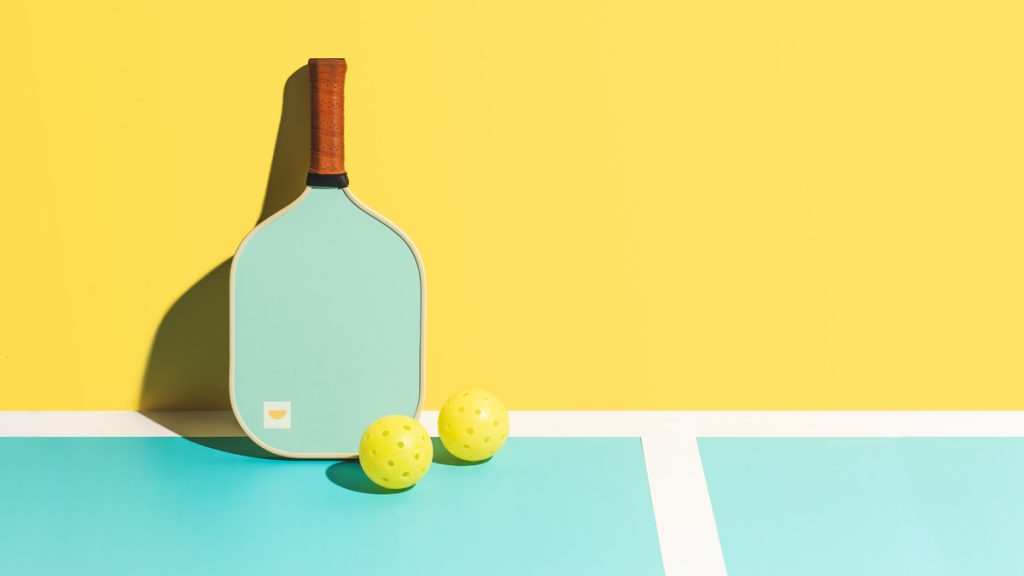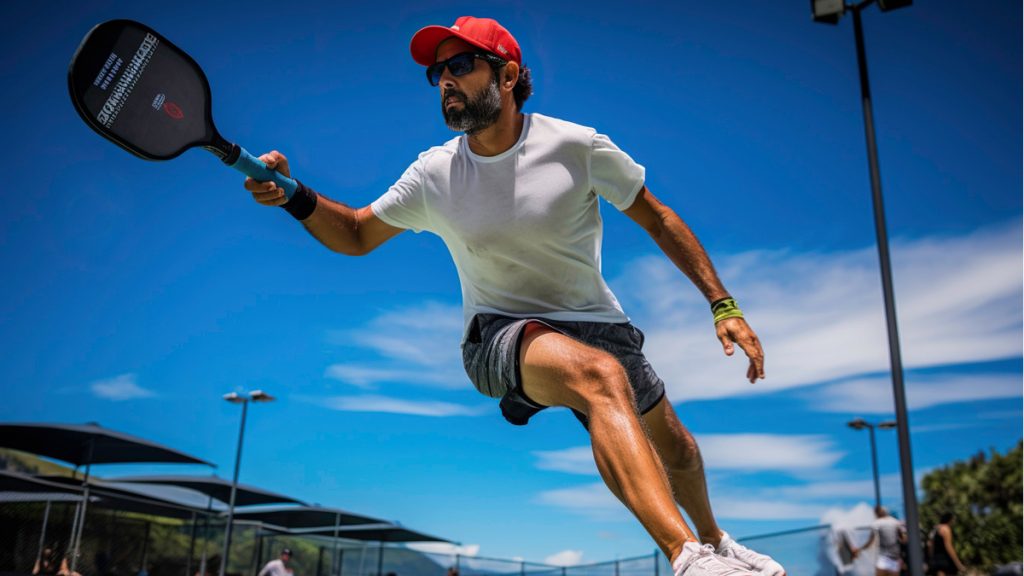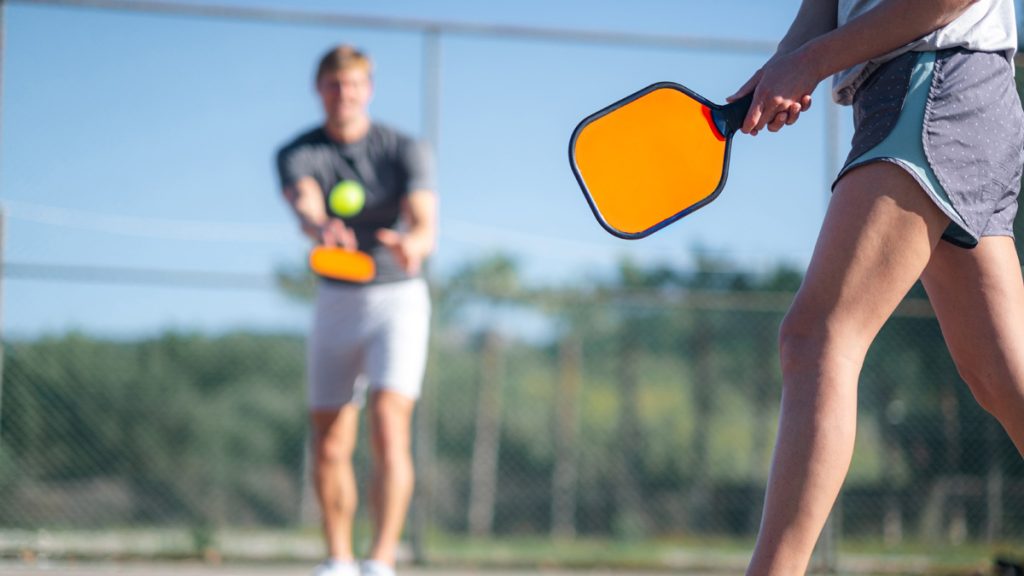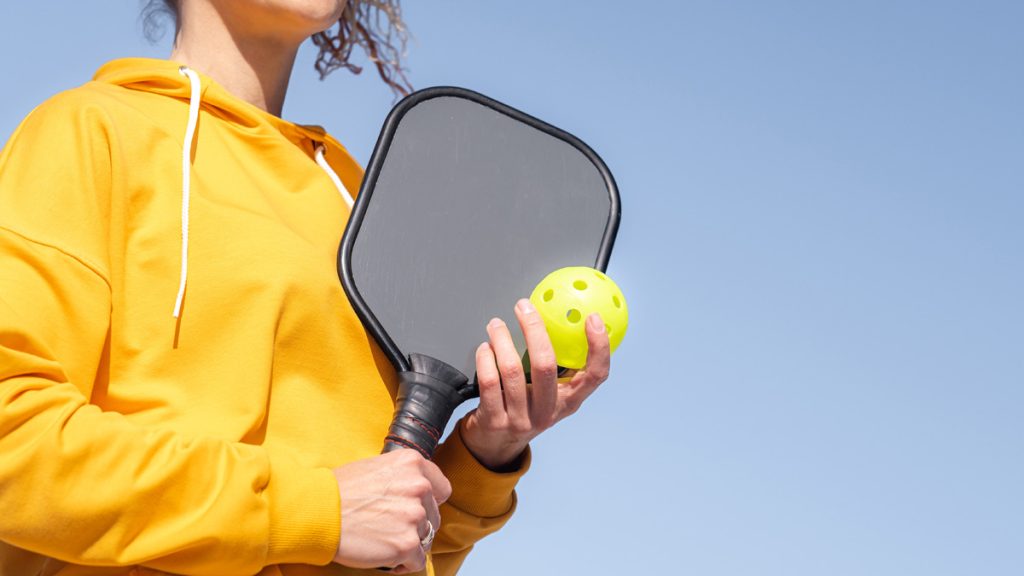The Best Pickleball Paddles for Beginners and Pros

If you live in California, Texas, Utah, Arizona, or Florida, you’ve likely witnessed a vast takeover of pickleball courts–popping up all over the map. It might be a sport with a funny name, but there’s no denying that pickleball is sweeping the nation. If you’ve ever taken a liking to table tennis, regular tennis, racketball, softball or baseball, there is a strong possibility you’ll want to join the pickleball bandwagon. Even if you’ve never engaged in any of these sports, it’s hard not to understand the hype after you step onto the court and get in some practice swings.
But really, any pickleball fanatic out there will vouch that pickleball is not only highly addictive, but also a great form of cardio that is both enjoyable and competitive–and it certainly keeps you on your toes. If you love social or competitive, fast-paced sports and want to try pickleball on for size, or are already knee-deep in the pickleball stratosphere and are ready to invest in a proper pickleball paddle, this article is meant for you.
So what are the best pickleball paddles? And what makes them so special?

Table of Contents
- Is There Really a Difference in Pickleball Paddles?
- How Do I Know What Pickleball Paddle to Use?
- Is It Better to Have a Lighter or Heavier Pickleball Paddle?
- What Are the Best Pickleball Paddles?
- Who Makes the Best Pickleball Paddles?
- What Are the Best Pickleball Paddles Made Of?
- Impact of Material on Performance and Durability
- Best Pickleball Paddles for Beginners
- How Do I Choose My Next Pickleball Paddle?
- Best Pickleball Paddles for Experienced Players
- Innovations in Pickleball Paddle Technology
- How to Maintain Your Pickleball Paddle
- Tips for Care and Longevity
Is There Really a Difference in Pickleball Paddles?
While it might not seem like a big dill on the surface, your pickleball paddle makes a huge difference in your A game. See what we did there 😉 Beginner or pro, a paddle is nothing without its player. You might know pickleball rules inside and out, but if you don’t have the right equipment then it’s game over. That said, a player can only achieve so much with the tools they use–so choosing wisely is a must.
Paddle variations provide different results for players of diverse skill levels, and each paddle has its own set of advantages and disadvantages. For example, the thickness of your paddle can lend to how much power and control you have over the ball. Thinner paddles tend to offer more power and agility, and are relatively lighter than their thicker counterparts. As you can imagine, the weight of a paddle will have a different effect on gameplay and player performance. Similarly, the surface materials and core materials directly impact control, power, speed, spin, and beyond.
How Do I Know What Pickleball Paddle to Use?

Are you a beginner or a pro? Paddleball preferences depend on your skill level, and factors to keep in mind include grip, weight, size, and thickness. Edgeguard and price also are important factors. But that’s not all, the materials of your face and core are key players in your performance and ability to follow through. After you’ve played a few rounds of pickleball, you’ll be able to determine your play style and what type of paddle weight you prefer–at least for the time being. With time and practice, you may want to adjust your paddle. But let’s not get ahead of ourselves, it’s going to take a while before you reach the status of Ben Johns or Anna Leigh Waters.
Guidelines for selection of a paddle include choosing a grip based on your hand size. Small hands work better with a thin grip, though they provide slightly less cushion. A thicker grip is perfect for people with larger hands or those who want more cushion and can handle the thickness without sacrificing their swing and stroke. A general rule of thumb is to measure the distance from the bottom lateral to the tip of your ring finger. Your number should be somewhere between 4-5 inches. This can help you determine what grip size is right for you.
Of course, there are more details to iron out, so let’s get into it. Next up–paddle weight.
Is It Better to Have a Lighter or Heavier Pickleball Paddle?
There is no denying that weight has an influence on player performance, especially since your wrist and arm strength play a factor in how much weight you are able to comfortably withstand for a long period of time when swinging and hitting the ball. Of course, which weight you choose for your paddle also boils down to player preference and skill level.
If you’re striving for a lighter pickleball paddle, which tends to be 7.3 ounces or less, some of the advantages include increased agility and more control. Lighter weight paddles are preferred for when you are playing doubles, as you have quicker hand speed. Players of fast pace play style table tennis, racquetball, might also prefer lighter paddles because it resembles ping pong paddles and lightweight rackets. It should also be noted that thinner paddles offer more pop and power.
If you’re striving for a medium-weight pickleball paddle, some perks are that faster hand speed, power, and precise shots. The added mass enhances stability and is effective at blocking shots. Mid-weight paddles are suited for those who can handle a bit more weight, noticeable vibrations, and paddle twisting, and those who are already comfortable with tennis players, as the weight feels more natural.
As for heavier pickleball paddles–typically 8.3 ounces and up–you’ll want to opt for this if you already have solid control over your shots, as they are more difficult to maneuver and place your shots, and there is an increased pop. These paddles excel at generating power, and are great for those who have a more aggressive style or those who struggle with consistently hitting their ball over the net. Get the heaviest paddle you can without sacrificing hand speed. If your wrist is sore halfway through your pickleball tournaments, that’s an indicator that your paddle is too heavy.
Essentially, anywhere between 7.3-8.3 ounces is great for beginners, and 7.8-8.3 ounces is typically a good weight range for the more experienced, where the paddle swing doesn’t feel too slow.
What Are the Best Pickleball Paddles?
If you’re keen on learning all about pickleball, you’ll want to understand what dinks, pops, and common pickleball lingo such as The Kitchen. You’ll also want to know what the features of high-quality paddles include. So what are the best pickleball paddles on the market, you ask?
Here’s an overview of top-rated paddles on the market, by category.
The best pickleball paddles for beginners include the PaddleTek New Era, the SLK Evo Power XL 2.0, the ONIX Graphite Z5. That said, there are TONS on the market, so it wouldn’t hurt to pop into your local sports gear shop and chat it up with a rep who can guide you to the best beginner paddle based on your individual needs and preferences.
For intermediate players the Volair Mach, Gearbox Pro Power Elongated Middleweight Carbon Fiber, and Head Gravity SH Middleweight Hybrid. The best paddles for advanced players include the Gearbox Pro Control Fusion, the Volai Mach 1 Forza, the Selkirk Amped McGuffin, the VANGUARD Power Air Invikta, and the Vulcan V720HT Max.
If you’re looking for paddles that provide spin, check out the Gearbox CX13 E Ultimate, the PRO XR T700 Raw Carbon, and the CRBN-1X Power Series. Budget-friendly paddles include the JOOLA Essentials or JOOLA Journey, Onix Graphite Z5, or the Head Radical Elite. For power, the Paddletek Tempest Wave Pro V3, the Vanguard 2.0 Epic, or the and the JOOLA Ben Johns Hyperion CFS 16MM.
Because there are so many paddles on the market produced by an eclectic array of manufacturers, consider this a general guideline for pickleball paddles and do your own research–perhaps testing out different paddles if you can find a try-before-you-buy sports shop.
Who Makes the Best Pickleball Paddles?
Now that we’ve examined some of the best pickleball paddles in 2024, let’s go deeper. Who makes the best pickleball paddles, you may be wondering? Given that there is so much hype around the sport, we are seeing more and more paddle manufacturers emerge each year.
Some of the leading brands in the pickleball paddle industry include Paddkletek, JOOLA, Gearbox, PCKL Pro, CRBN, Onix, Engage, Gamma, Head, Helium, Vulcan, Vanguard, Volair, and Selkirk. Of course, this is just a short list of the many manufacturers out there.
For the beginners out there–don’t be fooled by the appearance! Paddles from these makers and many others look similar, if not identical, but the materials and structural differences of these paddles is what drives performance. These seemingly small impacts on how well you play and what style you begin to adapt. Some paddles lay more focus on ergonomic grip and affordability, while others lay more focus on surface texture, spinnability, and the “sweet spot” area. Another tip–just because something is stylish, dressed up in bright colors and cool patterns does not mean it is the wisest choice for your A game. Do your research on the face, core, weight, dimensions, grip circumference, and overall performance before settling on a paddle.
What Are the Best Pickleball Paddles Made Of?

Pickleball materials matter, and we are here to fill you in on why. The core materials and surface materials of your paddle–paired with your skill, style, and strength–play a significant role in how well you are able to maneuver and hit the ball. What are the best pickleball paddles made of, you may ask? The most common materials a pickleball paddle is composed of include graphite, carbon fiber, fiberglass, wood, and even some hybrid options that combine multiple materials. Hybrid paddles, which consist of mixed materials, may offer a larger sweet spot and extra power depending on the materials.
Graphite pickleball paddles are the lightest and thinnest materials of the bunch–which may lead you to thinking that they are flimsy–but graphite paddles are actually quite firm and hard to bend. They are also decently powerful, but you’ll need to rely more on your technique to make sure your swing and hit will get the job done. This paddle is for those who are better with control and maneuvering and don’t need too much power from the paddle.
Carbon fiber–which is a polymer, a form of graphite–has a similar stiffness to graphite but is even more durable and offers more power. Carbon fiber paddles offer consistency and precision for your shots, and some control. Just note that for carbon fiber paddles, you’ll have increased spinability when compared with graphite, but for a higher price point.
Fiberglass paddles, which are typically light to medium-weight, focus heavily on precision over power. Fiberglass paddles are among the most common paddle surface materials of recreational players. These paddles are more durable and stiff than their graphite counterparts, and the distinct texture lends to enhanced spinability and pinpoint accuracy. Energy distribution isn’t evenly spread across the entire surface of the paddle–resulting in a smaller sweet spot–so this surface material is more idealistic for intermediate and advanced players.
Wooden paddles–the OG material for paddles–is not as popular of a paddle choice as it used to be. The reason for this being the heavy weight, which can tire our wrists and arms, a culprit for fatiguing players quicker during games. Wood is seen often in lower quality starter sets for beginners. The wooden core is not as uniform and consistent as a honeycomb core and is prone to more edge scrapes and chips. The inconsistency of a hit–much like a ping pong ball–also implies that it is not the best for spin. Power, however, is definitely a plus with wooden paddles.

Impact of Material on Performance and Durability
Armed with this information, you’re probably even more confused about which pickleball paddle to go with. But wait, there is even more to unravel when it comes to pickleball paddle preferences!
The core materials of your pickleball are just as important as the surface materials. Polymer and Polypropylene are often at the core of the most sturdy and functional paddles on the market, as they produce less noise than their counterparts and have a design that lends to leverage and control. This plastic core blend is both soft and durable, flexible and strong, with honeycomb cells to provide consistency. Pros and afternoon players alike will often have polymer and polypropylene as their paddle core. However, it’s not a one size fits all. Some may prefer an even harder material.
In this case, Nomex as a core is a great option. Nomex is tough, durable, and resistant, with a similar consistency to cardboard with a small honeycomb design. Nomex cores provide ample power, as they are dipped in resin to produce a hard shell. This core was the first material used in high-performance, high-caliber pickleball paddles. Due to their components, Nomex core paddles tend to be louder than its Polymer counterparts, but if you don’t mind the noise, then Nomex is a fine choice for power and speed.
There are also paddles with an aluminum core, which tend to be more lightweight with a honeycomb design. This type of paddle is great for a junior or beginner player, but for those who play on a regular basis, you’ll want to side with one of the former options.
So, do you think you have a better grip on what are the best pickleball paddles yet?
Best Pickleball Paddles for Beginners
For the newbies, you’ll want to think of your paddle like an extension of your hand. Your paddle type influences how you play, how much power and control you have, and how much spin you’re able to get during a hit. The best pickleball paddles for beginners are ones that offer consistency, power, and are relatively lightweight. You want something that won’t fatigue you or make your arms feel sore halfway through the game, but something that gives you better control. Ensure that your paddle has a comfortable hand grip, is easy to finesse and hold, and is within a decent price range–no need to drop the big bucks for your first paddle if you are an absolute beginner!
New technologies and innovations of the traditional pickleball paddle are constantly emerging to keep up with style, efficiency, and functionality. We are witnessing upgraded materials and grips, brand-spanking new core designs, and artfully designed textured surfaces that enhance spin and increase control. Composite, graphite, polymer are typically those for beginner paddles. Why? With graphite you have better control, and with polymer you have more power and durability. The best pickleball paddles currently on the market for beginners include the PaddleTek New Era, the SLK Evo Power XL 2.0, the ONIX Graphite Z5, Holbrook Sport Alta, and the Vatic Pro.
How Do I Choose My Next Pickleball Paddle?
You’ll want to consider paddle shape, face and core material(s) of the paddle, core thickness, the surface material of the paddle, the length of the paddle handle, the weight, and the grip of your paddle, and price point. A paddle with a thick grip might not be the best choice for someone with smaller hands, just as a lighter paddle might not be the best choice for someone who has a lot of upper body and arm strength.
If you currently own a paddle, start by investigating upgrades to the brand you already have. There are tons of innovations and revamps and 2.0 or even 3.0 versions of paddles, so check to see if the paddle you have has any updated models first.
Say you’ve gained upper body strength and don’t need as much power, or have mastered maneuverability and don’t need a paddle with much control. Evolving play styles and needs will naturally occur with time and practice, so take into account everything aforementioned and where you currently stand as a pickleball player. It could be worth consulting with a pickleball pro shop or testing out friends’ paddles before making an investment in a new paddle.
Best Pickleball Paddles for Experienced Players
For the experienced player, the best pickleball paddles on the market are ones that provide power, control, and maneuverability. Paddles can range from cheap to cheap to $150-$275 for higher end, pro paddles, and there are different features that appeal to advanced players.
Recommendations for competitive play include paddles that have some spin, and 100% control, and some forgiveness. That said, some players who can finesse powerful shots with little paddle control might opt for a paddle that offers less consistency but is heavier. Figure out what you specifically want in a paddle based on what your current strong skills are.
Some brand name paddles that the pros are using include the JOOLA Pickleball, which has elongated paddle shape that offers 100% control and some spin and power–worlds #1 Ben John’s new paddle is good for any intermediate to advanced players. Six Zero Double Black Diamond Control is another divine paddle for experienced players looking for spin, power, control, and forgiveness, and those who can handle dinks and pops. The Legacy Pro and Paddletek Bantam ALW-C are two other solid options for the advanced player.
Innovations in Pickleball Paddle Technology
So what are the latest advancements and their benefits? How is technology shaping the future of paddles?
Due to the increased desire for eco-friendly, sustainable products, we are seeing more sustainable pickleball paddles on the rise. We are also seeing enhancements in product quality and efficiency thanks to the utilization of artificial intelligence and machine learning, which has proven useful in developing design functions that outperform conventional paddles.
Gel-core technology, silicone–infused honeycomb technology has become a huge craze. The hybrid materials help retain the durability of nomex-like core, with noise and vibration reduction from a polypropylene-like core. This new tech can outperform other paddles and is beneficial to all types of players.
There are over 600 pickleball paddle makers on the market currently–and I’m sure we will see more within the new year!
How to Maintain Your Pickleball Paddle

Of course, there will be a time when you’ll have to bid farewell to your beloved paddle and part ways. Wear and tear is inevitable, especially with frequent use, but how does one determine when it’s time to throw in the towel and search for a new paddle? If you’re a recreational player, you’ll get more longevity and durability out of your paddle than a professional player who plays in a lot of tournaments and practices regularly. Players who only get out there occasionally and play more for casual fun likely won’t have to replace their paddle for at least a year, and sometimes paddles can even last up to 5 years if hardly used and maintained well.
High performance pickleball players, on the other hand, will likely only get 3-6 months use out of their paddle before noticeable wear and tear. If you are replacing your paddle every 3-6 months, and spending around $100-$250 on a paddle, it’s important to keep in mind the ongoing expenses of the sport.
Unsure if you need a replacement? Tap around the surface area paddle to hear and touch where the paddle feels and sounds dead. Another way to test is by hitting the pickleball–which will feel different when you hit it in these dead spots. Dead zones are commonly found above the handle as well as on the corners and very top of the paddle, which is a sign that your pickleball paddle is on its way out. Similarly, if your paddle is chipped, worn down, and suffers dents on the face, your paddle won’t operate at optimal performance anymore.
Tips for Care and Longevity
Do you want a competitive edge? Aside from practice, precision, and pickleball lessons, you’ll want to maintain your pickleball paddle by stowing it in a safe space and regularly cleaning it with the proper cleaning tools.
Tips for personal care of your paddle include cleaning the paddle face and grip after every use. Use soap and water, and avoid household cleaners with heavy chemicals, which can leave behind a sticky residue and erode the material. Regular cleaning can look like using water and a lint-free cloth. Dampen the cloth and gently scrub away dirt and residue on the paddle face and edge guard, and wipe both the grip and the face. Then use a dry cloth afterwards to ensure the paddle is dry. Aside from cleaning the cloth, avoid getting paddle wet, as this can destroy the paddle and hinder performance. The honeycomb core of certain paddles can trap water inside the paddle face, causing irreversible damage. If you have a raw carbon fiber paddle, note that your paddle face is grainier and can accumulate more debris, so you can use a carbon fiber cleaning block to help remove grime.
Other suggestions include avoiding extreme temperatures, which can also cause permanent damage. Cold air can cause your paddle to become brittle and breakable, and excessive heat can create soft spots in your paddle, sometimes leading to delamination. With this in mind, it is best to store your paddle in a dry, room-temperature closet. To keep your outer edges of your paddle protected, you can add edge guard tape. Be aware that graphics, no matter the core or face material, are prone to naturally fade away with repeated use.
Remember, some of the best beginner pickleball paddles don’t cost an arm and a leg, and it’s smart to reserve your purchase on a pricey paddleball only once you get the hang of it. Novice or pro, it’s crucial to select the appropriate paddle by first investing time and research into selecting the best paddle for you, if you plan to achieve successful outcomes during your pickleball matches, that is. And who doesn’t want to win the game?! Now that you’re aware of all the tips and tricks, go out there and get yourself a paddle, and play ball!
Media credit: Images licensed from Adobe
Courtney is a San Diego-based, San Francisco bred millennial with a passion for design and self-expression. She prides herself in her charcuterie board making skills and has a soft spot for animals. When she’s not writing, you can catch her playing tennis and enjoying the diversity of events and restaurants San Diego has to offer.





